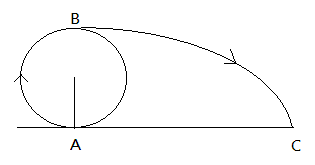
A body is rotated in the vertical plane by means of thread of length $l = 4m$ with minimum possible speed. At the highest point B the thread breaks and the body moves under gravity and strikes at C. What is horizontal range AC (in m)?


Answer
557.1k+ views
Hint: Just before breaking there will be three forces acting on the body at point B. From there we will get velocity. After that we can solve this problem considering that a body at height $l = 4m$ is projected horizontally. Calculate range for this case.
Complete step by step answer:
Let's first understand the question, a body is tied to a thread of length $l = 4m$ , the thread is vertically rotated just like a ferris wheel. Now when the body reaches at point B, that is at the top, the thread breaks.
Let’s understand what happens at this point. At point B, the body was in rotation due to the centripetal force and when the thread breaks, this centripetal force no longer acts on the body.
At this point only gravitational force acts on the body, so at point B just before breaking, centripetal force must be equal to the gravitational force.
$$ \Rightarrow R = 2 \times 4 = 2l = 8m$$
Where $m$ is the mass of the body.
$v$ is the velocity of the body
$g$ is the acceleration due to gravity
And $r$ is the radius of the circle in rotational motion.
Here $r = l$ , solving above equation we have:
$v = \sqrt {gl} $
The range from point B, is given by the formula
$$R = v\sqrt {\dfrac{{2(2l)}}{g}} $$
$$ \Rightarrow R = \sqrt {gl} \sqrt {\dfrac{{2(2l)}}{g}} $$
$$ \Rightarrow R = 2l$$
$$ \therefore R = 2 \times 4 = 8m$$
Therefore, the horizontal range AC is $$8m$$
Note:
Remember that at point B tension is also acting on the body but as soon as the thread breaks, tension becomes zero. The formula of range for such cases must be remembered.
Alternate solution; after thread breaks, calculate time taken for the body to cover a vertical distance of $$2l = 8m$$ . Now we have time and velocity at point B, so horizontal range can be easily calculated.
Complete step by step answer:
Let's first understand the question, a body is tied to a thread of length $l = 4m$ , the thread is vertically rotated just like a ferris wheel. Now when the body reaches at point B, that is at the top, the thread breaks.
Let’s understand what happens at this point. At point B, the body was in rotation due to the centripetal force and when the thread breaks, this centripetal force no longer acts on the body.
At this point only gravitational force acts on the body, so at point B just before breaking, centripetal force must be equal to the gravitational force.
$$ \Rightarrow R = 2 \times 4 = 2l = 8m$$
Where $m$ is the mass of the body.
$v$ is the velocity of the body
$g$ is the acceleration due to gravity
And $r$ is the radius of the circle in rotational motion.
Here $r = l$ , solving above equation we have:
$v = \sqrt {gl} $
The range from point B, is given by the formula
$$R = v\sqrt {\dfrac{{2(2l)}}{g}} $$
$$ \Rightarrow R = \sqrt {gl} \sqrt {\dfrac{{2(2l)}}{g}} $$
$$ \Rightarrow R = 2l$$
$$ \therefore R = 2 \times 4 = 8m$$
Therefore, the horizontal range AC is $$8m$$
Note:
Remember that at point B tension is also acting on the body but as soon as the thread breaks, tension becomes zero. The formula of range for such cases must be remembered.
Alternate solution; after thread breaks, calculate time taken for the body to cover a vertical distance of $$2l = 8m$$ . Now we have time and velocity at point B, so horizontal range can be easily calculated.
Recently Updated Pages
Why are manures considered better than fertilizers class 11 biology CBSE

Find the coordinates of the midpoint of the line segment class 11 maths CBSE

Distinguish between static friction limiting friction class 11 physics CBSE

The Chairman of the constituent Assembly was A Jawaharlal class 11 social science CBSE

The first National Commission on Labour NCL submitted class 11 social science CBSE

Number of all subshell of n + l 7 is A 4 B 5 C 6 D class 11 chemistry CBSE

Trending doubts
What is meant by exothermic and endothermic reactions class 11 chemistry CBSE

10 examples of friction in our daily life

One Metric ton is equal to kg A 10000 B 1000 C 100 class 11 physics CBSE

1 Quintal is equal to a 110 kg b 10 kg c 100kg d 1000 class 11 physics CBSE

Difference Between Prokaryotic Cells and Eukaryotic Cells

What are Quantum numbers Explain the quantum number class 11 chemistry CBSE




